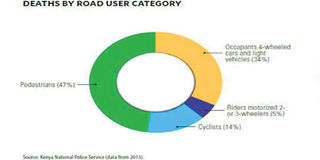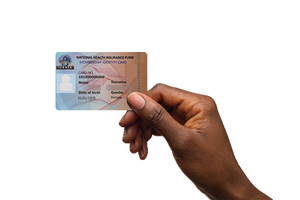Experts seek initiatives to reduce pedestrian deaths

A graphic in the 2015 Global Status Report on Road Safety released on October 19, 2015 showing road traffic deaths in Kenya. PHOTO | NMG
What you need to know:
At the same time, Kenya has been listed among countries that have no adequate measures to reduce pedestrian deaths.
New cars should incorporate features that would help reduce the deaths of pedestrians and motorcyclists, a new report says.
At the same time, Kenya has been listed among countries that have no adequate measures to reduce pedestrian deaths.
According to the 2015 Global Status Report on Road Safety released Monday in Geneva, insufficient attention has been paid to the needs of pedestrians, cyclists and motorcyclists, who together make up 49 per cent of all global road traffic deaths.
The report revealed that vehicles can be built to safeguard pedestrians in case of a crash. However, only a few countries, mostly in Europe, have implemented such measures.
“Only 44 countries apply this regulation and again, these are overwhelmingly high-income European countries. Indeed, only one African country (South Africa) applies this standard,” the report states.
The report stated that vehicle designs should incorporate features to protect pedestrians by reducing the likelihood of collision and reduce the severity of injury in the event of a crash.
These features include softer bumpers, combined with better bonnet area clearance and removal of unnecessarily rigid structures.
In recommendations contained in the report, governments were asked to sign up to the minimum international vehicle standards as requirements for manufacturers and assemblers.
“These standards are not only important to protecting car occupants involved in a crash but are also essential to protecting pedestrians, cyclists and motorcyclists,” the report states.
Profiles of countries included in the report indicate that Kenya has put in place road safety measures targeting motorists, including laws on speed limits, drink-driving and use of seat belts, but none on safeguarding pedestrians.
The report states that a survey done in the country ranked the enforcement rate of laws targeting motorists as “effective”.
However, the survey showed that enforcement of laws that require motorcyclists and their passengers to wear helmets is low. A report by the National Transport and Safety Authority (NTSA) shows 1,024 pedestrians, 326 motorcyclists, 58 cyclists and 161 passengers were killed in road crashes between January and October 15 this year.
In a statement Monday, Dr Etienne Krug, director of WHO’s Department for Management of Noncommunicable Diseases, Disability, Violence and Injury Prevention, called for more urgent measures to be taken to protect pedestrians and motorcyclists. (NMG)




